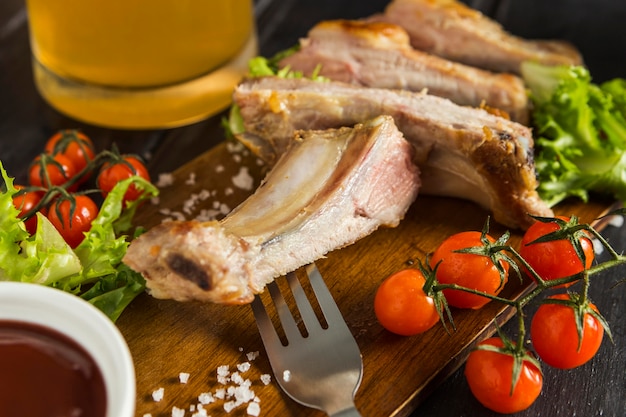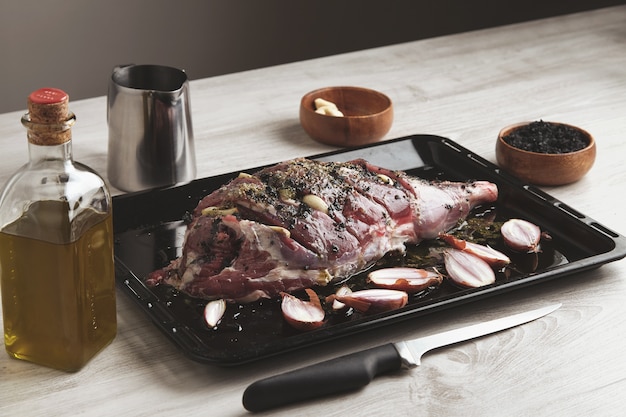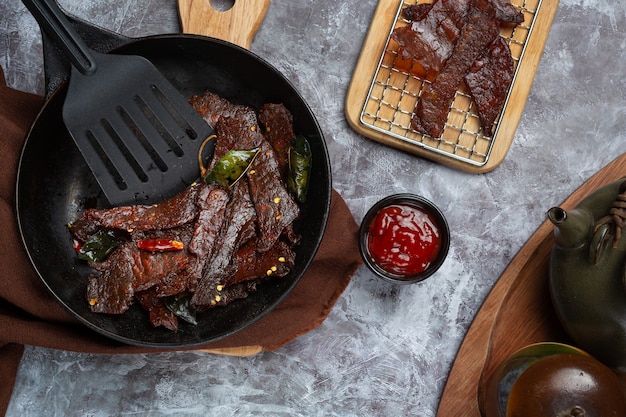(Part 1) The Art of Selection: Choosing Your Rib Roast

1. The Prime vs. Choice Debate: A Question of Quality
Let's face it, prime rib is the Rolls Royce of beef. It boasts a higher fat marbling, which translates to a richer flavor and melt-in-your-mouth tenderness. It's the top tier, the crème de la crème. Now, Choice isn't a bad option at all; it's just more budget-friendly. If you're looking for a delicious rib roast without breaking the bank, Choice is a solid choice. Personally, I'm a Prime enthusiast. It's a special occasion, so why not go all out?2. The Bone-In Advantage: A Flavor Booster
Bone-in rib roast, that's where it's at. It's not just about aesthetics (although, let's be honest, that bone looks fantastic!). The bone acts like a heat conductor, holding in moisture and intensifying the flavor. It's a culinary symphony, and the bone is the conductor, orchestrating a beautiful melody of taste and tenderness.3. Size Matters: A Roast for Every Occasion
Rib roasts come in a variety of sizes, so consider your guest list and the grandness of your gathering. A smaller 3-rib roast is perfect for a romantic dinner for two, while a 5-rib roast is a good choice for a family gathering. For a real showstopper, go for a 7-rib roast that can feed a hungry crowd. Think of it like tailoring your roast to the occasion.(Part 2) Prepping for Perfection: Setting the Stage for a Stellar Roast

1. The Salt-and-Pepper Symphony: Keeping it Simple
Don't overthink this! A simple sprinkle of salt and pepper is all you need. I prefer kosher salt because it's coarser and distributes evenly, ensuring the flavor is evenly distributed across the roast. You can get fancy with other seasonings, but a classic salt-and-pepper rub is more than enough to enhance the natural flavor of the beef. Sometimes, less is more, especially when it comes to showcasing the inherent taste of quality beef.2. The Art of Patting Dry: Creating a Crispy Crust
Before you hit the oven, pat your roast dry with paper towels. This is crucial for achieving a beautiful, crispy crust. Excess moisture will steam the meat, preventing a nice sear. Think of it as letting the roast breathe before it enters the oven's embrace.3. The Rest is Key: Ensuring Even Cooking
Let your roast rest at room temperature for about an hour before cooking. This allows the meat to come to a more even temperature, resulting in a more consistent cook. It's about giving the roast a chance to acclimate before it faces the heat.(Part 3) The Roasting Ritual: A Journey to Tenderness

1. The Sizzling Start: Locking in Flavor
Place your rib roast in a roasting pan and pop it in the oven. Aim for a beautiful golden-brown crust on all sides. This initial sear locks in the juices and creates a delightful crust, a testament to the heat's transformative power.2. Temperature Taming: Achieving Even Cooking
After the initial sear, it's time to reduce the heat to 325°F. This keeps the internal temperature rising gradually, ensuring the roast cooks evenly. Remember, slow and steady wins the race when it comes to roasting. Think of it as a controlled, gentle rise in temperature, like watching a beautiful sunrise.3. The Tell-Tale Signs: Monitoring the Roast's Journey
While your rib roast is happily roasting, keep an eye on the internal temperature. You're looking for a juicy medium-rare, with an internal temperature of 135°F. A meat thermometer is your best friend here. It's like monitoring the roast's progress on its culinary journey.4. The Resting Ritual: Allowing the Juices to Redistribute
Once the roast reaches your desired temperature, it's time to let it rest. Cover it with foil and allow it to cool for at least 30 minutes. This gives the juices time to redistribute, ensuring a juicy and tender masterpiece. This is the final step, the grand finale, where the roast reaches its peak of deliciousness.(Part 4) The Carving Conundrum: A Culinary Symphony
The big moment has arrived. It's time to carve! This is your chance to transform that beautiful rib roast into juicy, succulent slices. It's like revealing the hidden treasure within the roast, a culinary masterpiece waiting to be enjoyed.1. The Tools of the Trade: Sharp Carving Knife
For the best results, you'll need a sharp carving knife. It'll slice through the meat effortlessly, giving you perfect, even slices. If you're not a carving pro, don't worry; it's easier than it looks. Think of the carving knife as your conductor's baton, guiding you through the symphony of flavors.2. The Slice and Serve Strategy: Revealing the Beauty Within
Start by carving alongside the bone, creating long, thin slices. Cut against the grain to make the meat more tender and easier to chew. You can serve it on a platter, or directly on individual plates. It's like unveiling a work of art, revealing the beauty within the roast.3. A Feast for the Senses: Savoring the Culinary Masterpiece
Now, it's time to enjoy your culinary masterpiece. That beautifully browned crust, the succulent, tender meat, and the rich, savory juices – it's a feast for all the senses. Don't forget to drizzle the juices over the slices for extra flavor. This is the moment you've been waiting for, the culmination of your culinary journey.(Part 5) Accompanying Acts: The Perfect Sidekicks
No rib roast is complete without a supporting cast of delicious side dishes. Think of them as the chorus, adding harmony to the main performance.1. Roasted Root Vegetables: A Symphony of Sweet and Earthy
The earthy sweetness of roasted root vegetables complements the richness of the roast perfectly. Try a medley of carrots, potatoes, and parsnips tossed in olive oil, salt, and pepper. The root vegetables provide a beautiful counterpoint to the savory richness of the roast.2. Creamed Spinach: Creamy Contrast
The creamy, velvety texture of creamed spinach provides a delightful contrast to the rich meat. I add a touch of nutmeg for an extra layer of flavour. The creamy spinach adds a touch of elegance and finesse, a subtle symphony of textures.3. Garlic mashed potatoes: A Classic Side Dish
A classic side dish that’s always a crowd-pleaser. You can't go wrong with fluffy, garlicky mashed potatoes. The simplicity of the mashed potatoes provides a comforting backdrop for the star of the show.4. Green bean salad: A Touch of Freshness
For a fresh and vibrant touch, a green bean salad with a tangy vinaigrette adds a refreshing element to the meal. The green bean salad adds a touch of lightness and acidity, a refreshing counterpoint to the richness of the roast.(Part 6) Sauce Secrets: Elevating the Flavor Profile
A delicious sauce can take your rib roast to the next level. Think of it as the finishing touch, the final flourish that elevates the culinary masterpiece.1. Au Jus: The Classic Sauce
This classic sauce is made from the pan drippings, resulting in a rich and savory sauce. Simply deglaze the pan with red wine or beef broth, and simmer until reduced and thickened. It's a testament to the power of using the roast's natural juices to create a symphony of flavor.2. Horseradish Cream: A Tangy Contrast
The sharpness of horseradish adds a delightful contrast to the richness of the roast. Combine grated horseradish with sour cream or cream cheese, and season with salt and pepper. The horseradish cream adds a touch of brightness and acidity, a counterpoint to the roast's richness.3. Red Wine Reduction: Rich and Flavorful
A rich and flavorful sauce that elevates the taste of the meat. Simmer red wine with shallots, garlic, and herbs until reduced and syrupy. The red wine reduction adds a depth of flavor, a touch of sophistication to the culinary experience.(Part 7) Leftover Love: Turning the Rib Roast into a Feast
You might be surprised, but rib roast leftovers are a blessing in disguise. They open up a whole world of possibilities for delicious meals. Think of it as a second act, a continuation of the culinary journey.1. Beef Sandwiches: A Simple and Satisfying Treat
Slice the leftover roast thinly and pile it high on toasted bread. Add a dollop of horseradish cream or au jus for extra flavor. A comforting and satisfying treat, perfect for a casual lunch or dinner.2. Beef and potato soup: A Hearty and Comforting Option
Shred the leftover roast and add it to a hearty potato soup for a comforting and flavorful meal. The soup is a warm embrace, a perfect way to use the remaining roast.3. Beef Hash: A Delicious Brunch Option
Dice the leftover roast and sauté it with onions and potatoes. Serve with a fried egg for a delicious and satisfying brunch. The hash is a vibrant and flavorful way to repurpose the leftover roast.4. Beef Tacos: A Tex-Mex Delight
Shred the leftover roast and fill soft tortillas with your favorite toppings for a tasty and easy dinner. The tacos offer a fun and flavorful twist on the traditional rib roast experience.(Part 8) FAQ: Addressing Your Rib Roast Dilemmas
Let's answer some of your burning questions about rib roast. Think of this as a quick reference guide, addressing your culinary concerns.1. Can I Freeze a Rib Roast?
Yes, you can freeze a rib roast for up to 3 months. Wrap it tightly in plastic wrap and then foil before placing it in the freezer. Freezing allows you to enjoy the roast at your convenience, a culinary treasure to be enjoyed later.2. How Long Should I Roast a Rib Roast?
The roasting time depends on the size of the roast and the desired level of doneness. As a general rule, allow 15-20 minutes per pound for medium-rare. Think of it as a guideline, a starting point for your roasting journey.3. What Temperature Should I Roast a Rib Roast?
I prefer a high initial temperature of 450°F for a crispy crust, followed by 325°F for even cooking. The temperature plays a crucial role in achieving the desired crust and tenderness.4. Can I Use a Roasting Bag?
You can use a roasting bag, but it will result in a less crispy crust. If you prefer a moist and tender roast, a roasting bag is a good option. It's about choosing the technique that best suits your preference.5. What if My Rib Roast Is Too Dry?
If your rib roast ends up a bit dry, try slicing it thinly and adding it to a sauce or stew. This will rehydrate the meat and create a delicious dish. Sometimes, even the best-laid plans can lead to a slightly dry roast, but it's all about finding creative ways to repurpose and enhance the flavor.(Part 9) The Final Word: A culinary adventure
So, there you have it, my ultimate guide to bone-in rib roast perfection. It’s more than just a recipe; it’s a culinary adventure. It's about embracing the process, savoring every step, and creating a meal that's as memorable as it is delicious. Remember, cooking is an art form. Don't be afraid to experiment, add your own personal touch, and create a rib roast that’s uniquely yours. And don't forget to enjoy the journey. Happy roasting!Everyone is watching

Prime Rib Roast Cooking Time Chart: Per Pound Guide
Cooking TipsPrime rib roast. Just the name conjures images of lavish dinners, crackling fires, and hearty laughter. It’s ...

How Long to Bake Potatoes in the Oven (Perfect Every Time)
Cooking TipsBaked potatoes are a staple in my kitchen. They're incredibly versatile, delicious, and surprisingly easy to m...

Perfect Rice Every Time: The Ultimate Guide to Cooking Rice
Cooking TipsAs a self-proclaimed foodie, I've always been a bit obsessed with rice. It's the foundation of countless cuisi...

The Ultimate Guide to Cooking Asparagus: Tips, Techniques, and Recipes
Cooking TipsAsparagus. The mere mention of this spring delicacy conjures up images of vibrant green spears, crisp and burs...

Ultimate Guide to Cooking the Perfect Thanksgiving Turkey
Cooking TipsThanksgiving. Just the word conjures up images of overflowing tables laden with delicious food, the scent of r...
